Toradora on R1
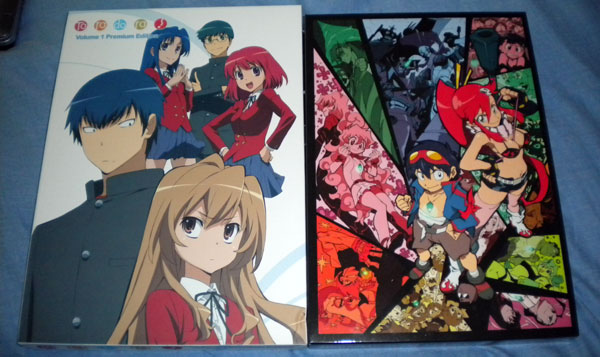
So, my copy of one of NISAs first DVD releases turned up today – that being the first Toradora set, being that I’m not really interested in Persona despite (or, given what I’ve heard, more likely because) of the fact that I’m a fan of the games. Of course, being the first release from a new publisher on the R1 side of things, particularly a release that’s generate a lot of talk for various reason, it’s certainly one what’s worth going into in some detail.
First off, it’s freaking huge. The only thing I have of a comparable size is last months R2 Gurren Lagann Parallel Works 2 release from last month – with which it’s pictured above. There’s really very little comparable on the market in terms of how this is packaged.
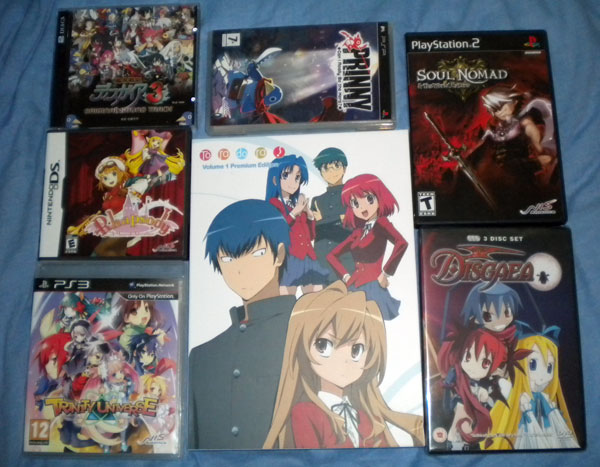
Size comparison against other common media
The box is pretty sturdy, being made of fairly thick chipboard. The two large faces both feature the same image, one in colour, one in monochrome. Of the two longer spines, one is blank, whilst the other features disk information.
The fact that I mention what’s on the two longer spines may make you question how you are supposed to get the content out of, and indeed back into, the box. Well, the opening is on the top, and things slide in and out of there.
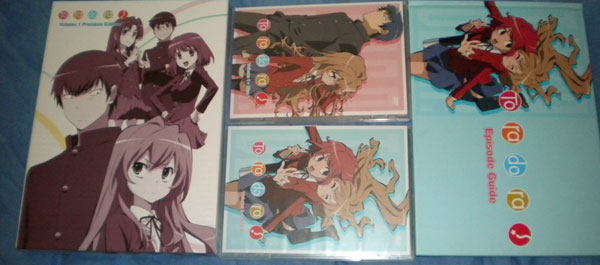
Inside the box there’s a hardback book, and the first thirteen episodes of the show on two DVDs in two Slimpack DVD cases. The book is the full height and width of the box, meaning that the two DVD cases lie end-to-end ontop of it. The issue with this is, of course, that you can only easily extract one of the DVD cases out without taking all of the content out of the box, but I guess that’s not the hugest of issues.
Although it’s how NIS are referring to it, Artbook is perhaps not the best term for the book which is shipping with the release. If anyone other than myself bought the LEs of the first season of Code Geass on R1, it’s a similar deal to the booklets which shipped with that release – very similar. Infact, as with the Code Geass release, I’m pretty sure that it’s a replication of the booklets that would have shipped with the Japanese Toradora DVDs, only reformatted to fit half the page count (which are, admittedly, pages that are probably around three times larger than those which typically ship with Japanese DVDs).
The content is partitioned off into chunks of episodes – strangely enough in portions relating to the number of episodes on each of the R2 disks. For each portion of the book, there’s a guide to the episodes, a selection of design art for the episodes in question, an interview with a member of the (Japanese) voice cast and another feature of varying format. It’s all nice supplementary material, and not the kind of thing we typically get in English, so it’s all appreciated.
Moving onto the actual disk, as is becoming normal for releases for companies other than Funimation, the disk is Japanese with Subtitles only. One peculiarity is that, upon insertion, the disk automatically jumps into the disks first episode. This is not an uncommon sensation for those who buy Japanese DVD releases, where this is common practice, but may weird out US customers. That said, given that it’s subtitle only, I guess there’s no reason to force you to the menu so that you can set-up your language selections. That isn’t to say that there isn’t a menu there for those who press the menu button, though.
I’ve only had a chance to watch through the first two episodes thus far. The subtitles seen to be pretty good – they’ve gone for white subtitles, and only white subtitles, which can make things a little confusing where more than one person is speaking, but otherwise they are clearly readable and stand-out well against the video. The only change to the video looks to be that the episode title cards appear to have been swapped out with English language ones, otherwise there’s no obvious hard-encoded changes to the video.
The translation looks to be fine from what I can tell – perhaps a little more idiosyncratic than most, but that’s mostly for Minori’s dialogue where it’d largely appropriate. Besides, it gives it a little character, which is certainly preferable than something that reads too dryly. There was one case where something that was actually spoken in English was rendered differently in the subtitles, which is always a little disconcerting, but there were unusual circumstances to that line of dialogue which permits me cut them some slack. They’ve left character names in Japanese order, which sounds like a silly thing to point out, but given how many R1 publishers still seem to insist on switching name orders in subtitles (or even wholesale swapping of family names with given ones), it’s always nice to see. The use of honorifics in the subtitles seem to be on a case by case basis – They’re mostly present, but some of the common ones are omitted on occasion – but not being part of the Honorific-mafia, that doesn’t bother me.
Now, onto the most sticky-wicket of a matter regarding this release. You may have already read about this elsewhere (or even some of my own thoughts in brief on other blogs), but there’s been plenty of talk about there being some video issues with both this release and Persona. At time of writing, NIS have even mentioned in the news on their own website (which, alas, I can’t get a direct link to) that they are looking into it, so this may not be a long-term issue anyway.
Fair warning here – you may not want to read any further. The actual issue going on here isn’t something that everyone notices. It’s not something that bothers everyone. It’s something that you can see similar effects of on other releases as a result of what you’re using to play them back even if it’s not present on the video. It’s also something that may become blindingly obvious and really, really annoying once it has been mentioned to you. I’m just giving you fair warning here. Also be baring in mind that I’m by no means an expert of video encoding, or even particularly interested in it.
Right, now the issues people are reporting are ghosting – that is frames of video that appear to have elements of a previous frame – and aliasing – that being evidenced in clearly pixellated lines. Both of these issues come down to TV anime typically consisting of interlaced video. Now, this may be me teaching people to suck eggs, but an interlaced video frame looks like this –
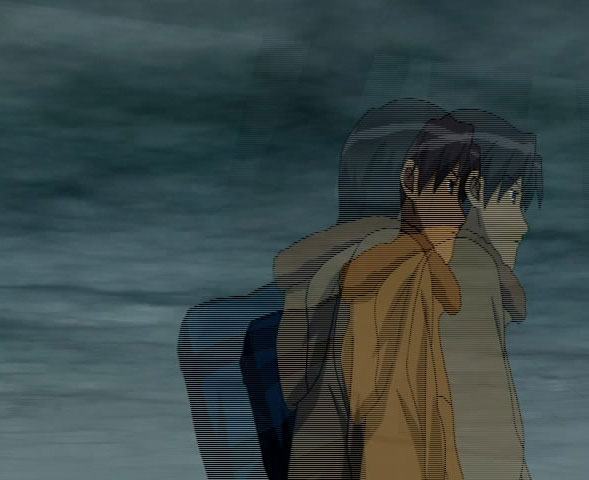
That is, an image where alternate lines are from two different images. Funny thing is that not all frames on interlaced anime DVDs are actually interlaced. No idea why, there’s probably a very good reason for it, (or probably just a coincidence based on not all frames of animation having movement), but that’s probably not important. Now, as far as the video clip from Haruhi I took that picture above from, one in every fourth to eighth frame is interlaced. Typically, you won’t see them – your DVD player (be it hardware or software) knows to de-interlace those frames into something less offensive. That said, depending on your set-up, “less offensive” can mean something very different.
Why is this important, might you ask? Well, the Toradora disk has a very similar set-up as far as it’s video encode goes, only there’s one problem with it…
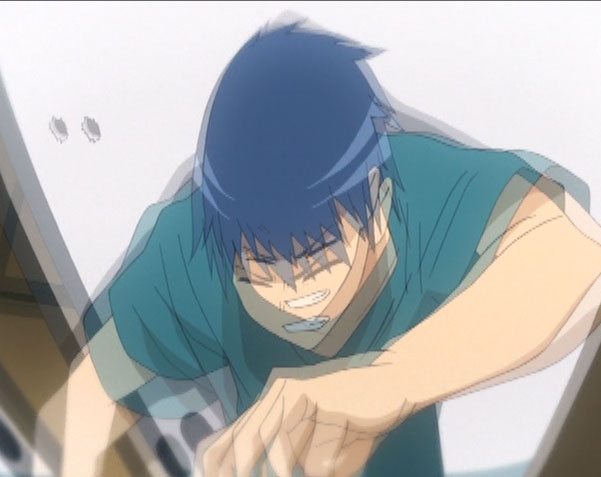
Now, bare in mind that this is supposed to be an interlaced frame. Your DVD player may even think that it’s an interlaced frame as well. The only thing is that, well, it’s not actually interlaced – it appears that the two frames have been merged together into one. Each line of the image contains information from each of the two fields that are supposed to make up the frame of the video. The result of this is that even if your DVD player is doing what it’s supposed to and trying to de-interlace it, there’s not much it can do as it’s now impossible to separate the two images. Even by completely discarding one field of information, the remaining field is still going to contain information from both images.
That’s why there’s visible ghosting and aliasing on these DVDs – frames of the video sporadically actually have details from two different images merged in a non-interlaced manner. Of course, some MPEG2 encoding solutions actually produce very similar results from their de-interlacing solutions (such as MPC’s internal MPEG2 filters preferred blending method), so it’s something that a lot of people may already live with and may not find to be annoying. On the other hand, it’s something that others are really hyper-sensitive to.
In terms of watching it, the main result is that camera pans tend to look a little on the smudged side. For what it’s worth, I don’t personally find it particularly bad on my main set-up (being my Sony HD telly with cheap Panasonic Blu-Ray player hooked up to it), but given I watch a lot of streaming anime, I see worse on a regular basis. That, and it’s far more palatable than the macro-blocked-to-hell releases Funimation where putting out a few years ago. It’s far from ideal, though, and it’s something I’d find far more distracting if I was trying to watch it on my PC based player.
As to how such a thing happens, that’s anyone’s guess. My personal one would be that at some point in their production process they’ve imported the interlaced video into something that’s decided to handle it as a progressive video (my money would be on whatever they used to add those English title cards), and then when they’ve rendered it back out it fudged the interlaced frames (may even have ran a “Blend” filter on it). Whatever caused it, rest assured that it’s not an issue with the player, or any other part of your playback hardware or software, that’s causing the ghosting effect. It’s in the video, and it’ll be in the video no-matter what you play it on. If you don’t notice it, that’s great for you, and I’m sure there are some people with this release who’d love to trade places with you. Personally, I’m not too bothered about it.

2010-07-01
#
Sorry to upstage you, I thought the comic was it.
2010-07-01
#
That last picture is how it will look if genuinely interlaced, but if your player program is set to deinterlace. Are you sure that’s not what happened?
I’ve only had one DVD that genuinely mixed neighboring frames in an attempt to convert 24 fps to 30 fps, and that was “Miyuki-chan in Wonderland”. Every other anime DVD I’ve ever bought just interlaced.
2010-07-01
#
Yeah, I was cautious about that – I demux’d the VOBs and imported the resulting MPEG2 file into a video-editing tool to grab that screenshot, as I did with the interlaced Haruhi image above. It should be free of the touch of any post-processing or filters. I fudged around with discarding one field of information from the source video entirely, but as I said above, the only thing that reveals is that information from both fields of the video is present on each line of the video. As I say, it looks like someone during the production process has done a poor-quality deinterlace at one point, either on purpose or accidentally.
2010-07-02
#
I’ve actually seen the above happen on encodes that I’ve done (er, that is, actual anime DVD encodes). The encoder would occasionally burp and a whole encode would come out like that, where the encoder got confused about which frames were A or B frames. Generally fixing it just entailed a quick re-encode.
If they’re like that EVERYWHERE, it implies that it’s not just their encoder occasionally suffering a problem; they’re probably got either a setting set wrong in their encoder, or something physically wrong in their master-to-encoder setup. (Speculating as to what goes beyond my competence. I was very lucky to have some top-notch people in charge of making sure my encoder was wired up properly. It’s a black art that I don’t comprehend.)
Big slip-up in their QC process to let this one go, but some people genuinely have a hard time seeing this particular encoding error. I wonder why? Might also be a lack of experience, given that these are NISA’s first projects; their DVD authoring house might have just told them “that’s the way it is” and they didn’t know any better.
2010-07-02
#
That was actually NISA’s immediate response when it was raised on their own forums. I’m inclined to believe them.